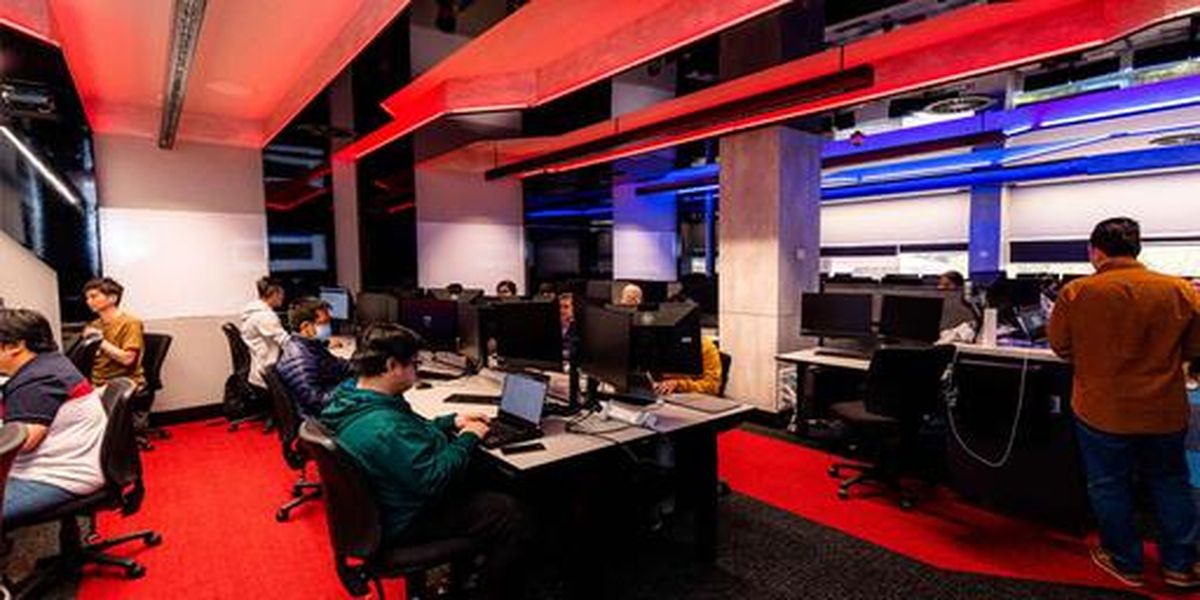Regional rocket launch delayed but experts say there are opportunities for Australia in the space race
Since the 1960s Australia has played a pivotal role in history’s biggest space missions, not least in helping NASA bring live television images of the first moonwalk to the world.
But our own space industry has never really achieved orbit.
While Australia has a long history of supporting space exploration, we’ve struggled to establish our own industry due to a lack of sustained investment and clear national strategy, according to Swinburne University’s Dr Rebecca Allen.
A technician monitoring rocket propulsion systems at Gilmour Rocket Technologies. (ABC News: Matt Eaton)
“Back in the days of the space race, there was a political motivation to be the first ones on the moon and show that we could beat the Soviets,” Dr Allen says.
“Playing this kind of supporting role made sense because of where we are.
“But to actually have a leading role and say, ‘We are going to be the ones now to launch our own rockets’, where’s the motivation for that?”
Gilmour Space Technologies has that motivation — but suffered from a failure to launch this week.
Dr Rebecca Allen says Australia has a long history of supporting space exploration. (Supplied)
The company’s Eris rocket launch was canned twice due to technical issues and a third attempt has been set for next month.
Dr Allen says the launch of Eris — whether or not it makes it into orbit — shows Australia can stand on its own two feet when it comes to designing and building rockets.
“We have real expertise in designing and manufacturing aerospace vehicles and I think it’s a chance to demonstrate that Australia is not just a supporting player,” she says.
Dr Allen says Australia has the capacity to be more than a supporting player in the space exploration sector. (ABC News: Matt Eaton)
A booming sector
The Space Industry Association of Australia (SIAA) is the peak body for the sector and says the global space economy is projected to reach $US1.8 trillion by 2035.
But chief executive Dan Lloyd says Australia remains a “customer” of global space technology, while its peers have developed clear and ambitious policies.
“Our geography is an amazing natural advantage, and we need to make sure that we capture an opportunity that’s bigger than just renting our dirt,” he says.
Dan Lloyd says Australia is still a “customer” of the global space technology market. (Supplied)
Mr Lloyd says Eris is a major milestone for Australia’s space industry and an opportunity to develop an ambitious and future-focused space policy.
“The industry is building to a critical mass,” he said.
“There’s a huge opportunity to clarify where Australia wants to place its bets, because there are some terrific bets to be placed.”
Beyond economic opportunities, Mr Lloyd says the growing number and severity of natural disasters shows a real need to develop our own capabilities.
Loading…
“Other countries that have significant investments and presence in space can get live satellite feeds and predictive monitoring that help to anticipate and manage bushfires,” he said.
Australia mostly borrows and buys this service from overseas, which can create a real problem during times of natural disaster, according to Mr Lloyd.
“There have been situations where Australia really needed live feeds of significant bushfires, but our international partners had challenges of their own and had to divert resources,” he says.
In an era of increasing global instability, Mr Lloyd says it’s important that Australia works to “fill those gaps”.
Enrico Palermo said the Australian Space Agency is working on fostering the local space sector. (ABC News: Lincoln Rothall)
Enrico Palermo, the head of the Australian Space Agency, said in a statement that the group was focused on “creating the right conditions” for the local space industry.
“This includes streamlining regulation, as well as agreements that open international investment opportunities like the Technology Safeguards Agreement with the United States,” Mr Palermo said.
That agreement allows US space technology to be launched from Australia, a move aimed at making the region more attractive for launching rockets and satellites.
A growing problem, and opportunity
There are around 10,000 active satellites in orbit but, less than a decade ago, there was only a fifth of that.
Billionaire Elon Musk’s Starlink network accounts for more than 7,000 of those satellites — forming a “constellation” with the aim of providing global mobile broadband.
More than 7,000 Starlink satellites have been launched into space. (AP: SpaceX)
Companies like Amazon are planning their own satellite constellations, and China is aiming to send tens of thousands of satellites into orbit over the next decade.
Mr Lloyd says the growing amount of “space junk” circling the planet is a huge challenge that no one has a good solution for.
But that challenge also represents opportunity.
There’s a number of engineers across Australia working on technology that can repurpose space junk. (ABC News: David Frearson)
“There are phenomenal Australian companies in research and development looking at harvesting space junk and potentially recycling it to use the conductive metals as new forms of propulsion in space,” Mr Lloyd says.
Mr Lloyd says Australia should focus on niche parts of the industry, like space junk harvesting, to differentiate itself from other countries.




